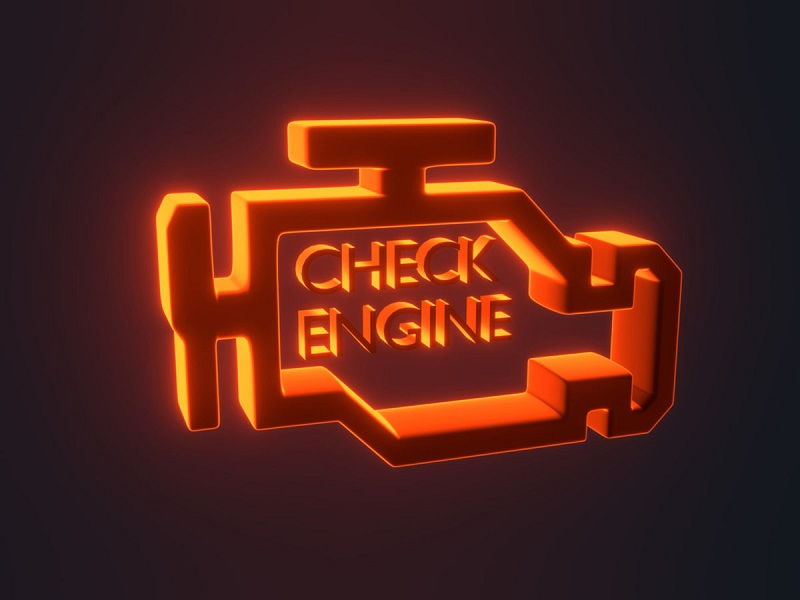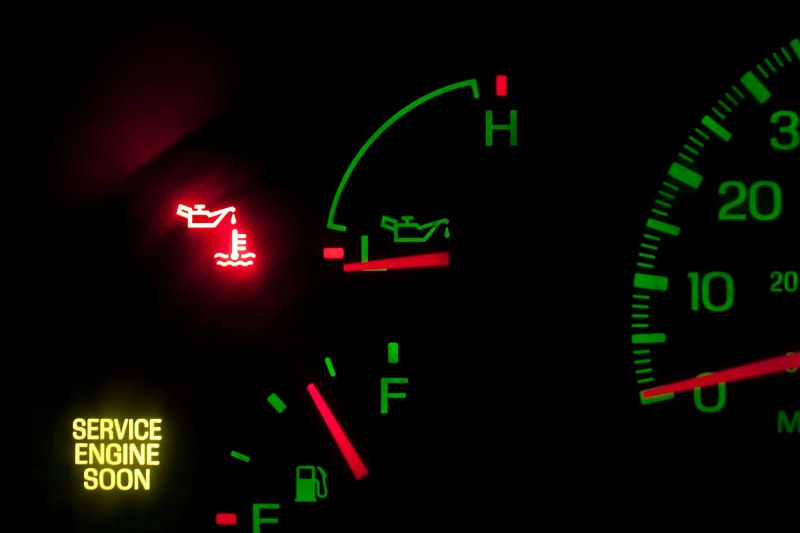This post contains affiliate links. This means I will make a commission at no extra cost to you should you click through and make a purchase [ “As an Amazon Associate, I earn from qualifying purchases.” ]. Read the full disclosure here.
Chevy Check Engine Light Flashing Then Stops GuideMechanic.Com The flashing check engine light on your Chevy can be a source of worry and confusion.
It’s a sign that something is wrong with your car, but it’s not always clear what that might be. Fortunately, there are a few steps you can take to diagnose the problem.
This article will discuss the potential causes of a Chevy check engine light flashing and then stops, and how to tell which one is causing your issue. We’ll also provide tips on how to troubleshoot and fix the problem.
What Causes the Check Engine Light to Flash and Then Stop in a Chevy?

The flashing of the check engine light in a Chevrolet vehicle can be caused by a variety of issues. It is important to note that the flashing of the check engine light is a sign of an issue that needs to be addressed immediately, as it could be an indication of an underlying problem that could cause further damage to the vehicle.
See Also: 2011 Chevy Equinox Oil: Recommend The Best Oil Type
In order to properly diagnose the issue, it is best to have the vehicle taken to a qualified mechanic or service center to have it inspected.
Common causes of a flashing check engine light in a Chevrolet include a faulty oxygen sensor, a faulty mass airflow sensor, a faulty catalytic converter, an issue with the spark plugs or wires, or a faulty ignition coil.
Depending on the make and model of the Chevrolet, other causes could include a loose or damaged gas cap, a faulty evaporative emission control system, or an issue with the fuel injectors.
In order to prevent further damage, it is recommended that any issue causing the check engine light to flash is addressed as soon as possible.
If the light stops flashing, it does not necessarily mean the issue has been resolved and the vehicle should still be inspected to determine the cause.
What to Do When Check
If your Chevy’s check engine light flashes and then stops, it is important to determine the source of the problem as soon as possible. Failure to do so may result in further damage to the engine.
The first step is to check the owner’s manual to find out what type of warning system is in your vehicle. Different models may have different warning systems, and the manual will provide detailed instructions on how to interpret the light.
Once you have determined what kind of warning system you have in your vehicle, you should check the engine to see if there is any sign of damage or leakage.
If there is, you should call a certified mechanic to inspect the engine and determine the cause of the problem.
See Also: P1101 Chevy Malibu 2016
If there is no visible sign of damage or leakage, you should reset the check engine light by disconnecting the negative battery cable for 15 minutes and then reconnecting it. This will reset the warning system and the light should no longer be flashing.
If the light continues to flash after resetting the system, you should take your vehicle to a certified mechanic for further inspection.
The mechanic will be able to determine the cause of the warning and provide recommendations for repairs.
It is important to take action as soon as possible when your Chevy’s check engine light flashes and then stops. Taking proper care of your vehicle will help to ensure its long-term performance and reliability.
Chevy Check Engine Light Flashing Then Stops
Common Causes
A flashing check engine light in a Chevy is a cause for concern and should be addressed as soon as possible.
he check engine light is an indicator of potential problems with the car’s engine, emissions, or other related systems.
Common causes for a flashing check engine light in a Chevy include a faulty oxygen sensor, a loose or damaged gas cap, a faulty catalytic converter, or a malfunctioning mass airflow sensor.
A faulty oxygen sensor can cause the check engine light to flash. The oxygen sensor is responsible for monitoring the amount of oxygen in the car’s exhaust system and sending the information to the engine control unit.
If the oxygen sensor fails or is damaged, the engine control unit will not receive the information it needs to properly adjust the fuel-air mixture, leading to a decrease in performance and a flashing check engine light.
See Also: 2004 Chevy Trailblazer Transmission
Another common cause of a flashing check engine light in a Chevy is a loose or damaged gas cap. Gas caps are designed to keep fuel vapors from escaping the fuel tank, which helps keep harmful pollutants out of the environment. If the gas cap is not properly sealed, fuel vapors will escape, causing the check engine light to flash.
A faulty catalytic converter can also cause the check engine light to flash. The catalytic converter is responsible for reducing harmful exhaust emissions, and if it malfunctions, the check engine light will flash.
Finally, a malfunctioning mass airflow sensor can cause the check engine light to flash. The mass airflow sensor is responsible for measuring the amount of air entering the engine, and if it fails, the engine control unit will not be able to properly adjust the fuel-air mixture. This will cause the check engine light to flash.
It is important to have any potential cause of a flashing check engine light in a Chevy diagnosed and repaired as soon as possible to avoid further damage to the car.
Chevy Check Engine Light Flashing Then Stops
Diagnosing

A flashing check engine light in a Chevy can indicate a serious problem with the vehicle. If the light is flashing, it is important to have the vehicle inspected as soon as possible to determine the cause of the problem.
When the check engine light is flashing, it is likely caused by a misfire, an issue with the catalytic converter, an issue with the engine coolant temperature sensor, or a vacuum leak.
If the light is flashing, it is important to have the vehicle inspected as soon as possible. A diagnostic scan should be done to determine the reason for the flashing check engine light. The scan will reveal the error code associated with the problem, which will indicate the cause of the issue.
Once the error code is obtained, a technician can determine the root cause of the problem. If the misfire is causing the check engine light to flash, the technician will check the spark plugs and wires, fuel injectors, and the fuel pressure.
If the issue is with the catalytic converter, the technician will inspect the oxygen sensors and catalytic converter.
If the engine coolant temperature sensor is the cause of the flashing light, the technician will check the sensor and its wiring.
See Also: P0014 Chevrolet Spin: Symptoms Of The P0014 Code
If a vacuum leak is the cause of the check engine light, the technician will inspect the intake manifold and its gaskets for any signs of a leak.
Once the root cause of the flashing check engine light is determined, the technician will then be able to repair the issue. It is important to have the issue addressed as soon as possible to avoid further damage to the vehicle.
How to Troubleshoot a Flashing Check Engine Light
Troubleshooting a flashing check engine light in a Chevy can be a complex process. However, with some basic knowledge and a few tools, it is possible to identify and fix the issue. The following steps will help you troubleshoot the problem.
-
Step 1: Check the Gas Cap
The most common cause of a flashing check engine light in a Chevy is a loose or damaged gas cap. This is a simple fix that only requires you to remove the gas cap and inspect it for any damage or looseness.
If the gas cap is loose, tighten it until it clicks. If the gas cap is damaged, replace it with a new one. Once the gas cap is securely fastened, the check engine light should turn off.
-
Step 2: Read the Trouble Code
If the check engine light continues to flash, you will need to read the trouble code. This can be done with an OBD-II scanner.
This device can be purchased from an auto parts store, or you can borrow or rent one from a local repair shop.
Once you have the scanner, plug it into the car’s OBD-II port, located near the steering wheel. The scanner will read the code and provide you with an explanation of what it means.
-
Step 3: Inspect Components
Once you have read the trouble code, you will need to inspect the components that could be causing the issue.
Depending on the code, this could be anything from a faulty spark plug to a clogged air filter. Make sure to check all components that could be related to the issue.
-
Step 4: Repair the Problem
Once you have identified the issue, you will need to repair it. This could mean replacing a faulty part or cleaning a clogged component. If the issue is beyond your skill level, it is best to take the car to a qualified mechanic.
Troubleshooting a flashing check engine light in a Chevy can be a daunting task. However, with some basic knowledge and the right tools, it is possible to identify and fix the issue.
Start by checking the gas cap and reading the trouble code. Once you have identified the problem, you can either repair it yourself or take the car to a qualified mechanic.
Understanding the Different Levels of Check Engine Light Flashing

Understanding the different levels of check engine light flashing in a Chevy can be a daunting task. However, it is important to understand these different levels in order to properly diagnose and repair any issues in your vehicle.
This article will provide a breakdown of the various levels of check engine light flashing in a Chevy, along with the potential causes and necessary solutions.
The first level of check engine light flashing in a Chevy is known as “hard flashing”. This occurs when the light flashes on and off rapidly, usually at a rate of four flashes per second.
This type of flashing indicates a serious problem and should be addressed immediately. Common causes of hard flashing include a faulty oxygen sensor, a fuel pressure regulator, a misfiring cylinder, or an engine oil pressure problem.
The next level is “soft flashing”, which occurs when the check engine light flashes at a slower rate of one to two flashes per second.
This type of flashing generally indicates a less serious issue with the vehicle, such as a vacuum leak or an incorrect fuel-to-air ratio.
The third level of check engine light flashing in a Chevy is known as “steady”. This occurs when the light remains on for an extended period of time.
Steady flashing generally indicates a more serious issue, such as a failed catalytic converter, a bad spark plug, or a defective electronic control module.
If you experience any of these levels of check engine light flashing in your Chevy, it is important to take your vehicle to a qualified technician as soon as possible. They will be able to diagnose the cause of the issue and provide the necessary repair services.
Understanding the different levels of check engine light flashing in a Chevy can help you properly diagnose and repair any issues in your vehicle and ensure that it is running at its best.
Chevy Check Engine Light Flashing Then Stops
When to Take Your Chevy to a Mechanic
It is important to take your Chevy to a mechanic if the check engine light is flashing. Flashing lights indicate a more serious problem than a steady light and require immediate attention. Ignoring this warning could lead to further damage and potentially costly repairs.
When the check engine light is flashing, it means the vehicle’s computer has detected a misfire or other severe problem that can damage the catalytic converter or other emission components.
A misfire is when the spark plug fails to ignite the fuel in the cylinder, causing the engine to run rough. This can also cause a loss of power.
If the check engine light is flashing, it is important to take your Chevy to a mechanic as soon as possible. The mechanic will be able to diagnose the problem and advise on the best course of action.
They may be able to fix the problem, or recommend further repairs. It is important to remember that the earlier the problem is addressed, the less likely it is to cause further damage.
In addition to taking your Chevy to a mechanic, it is also a good idea to have the vehicle serviced regularly. This will help identify any problems before they become serious, saving time and money in the long run.
What to Check for When the Check Engine Light Flashes and Then Stops
If the check engine light on your Chevy flashes and then stops, it is important to take the vehicle to a qualified mechanic as soon as possible.
The flashing light is a signal that the car’s computer has detected an issue with the engine, and this should not be ignored.
The mechanic will use a scan tool to access the car’s onboard diagnostic system, which will provide information about any problems the car may be experiencing. The technician will then be able to diagnose the cause of the issue and recommend the necessary repairs.
When the check engine light is flashing, it is important to check for other symptoms such as a decrease in fuel economy, misfiring or difficulty starting the engine. It is also a good idea to check the oil and coolant levels, as these can be indicators of a problem.
If the check engine light continues to flash, it is important to have the car serviced as soon as possible. Ignoring the issue could result in further damage to the car’s components, leading to more costly repairs. It could also put the safety of the driver and other road users at risk.
Conclusion
In conclusion, a Chevy check engine light flashing and then stopping can be a sign of a variety of issues, ranging from minor to serious.
It is important to get the vehicle checked out as soon as possible to ensure the issue is fixed before it becomes a larger problem.
- P0000 Through P0099: Understanding OBD-II Trouble Codes - February 11, 2025
- P0000 Through P0199: Understanding OBD-II Trouble Codes - February 10, 2025
- P0080 Exhaust Valve Control Solenoid Circuit High (Bank 1) - February 9, 2025
